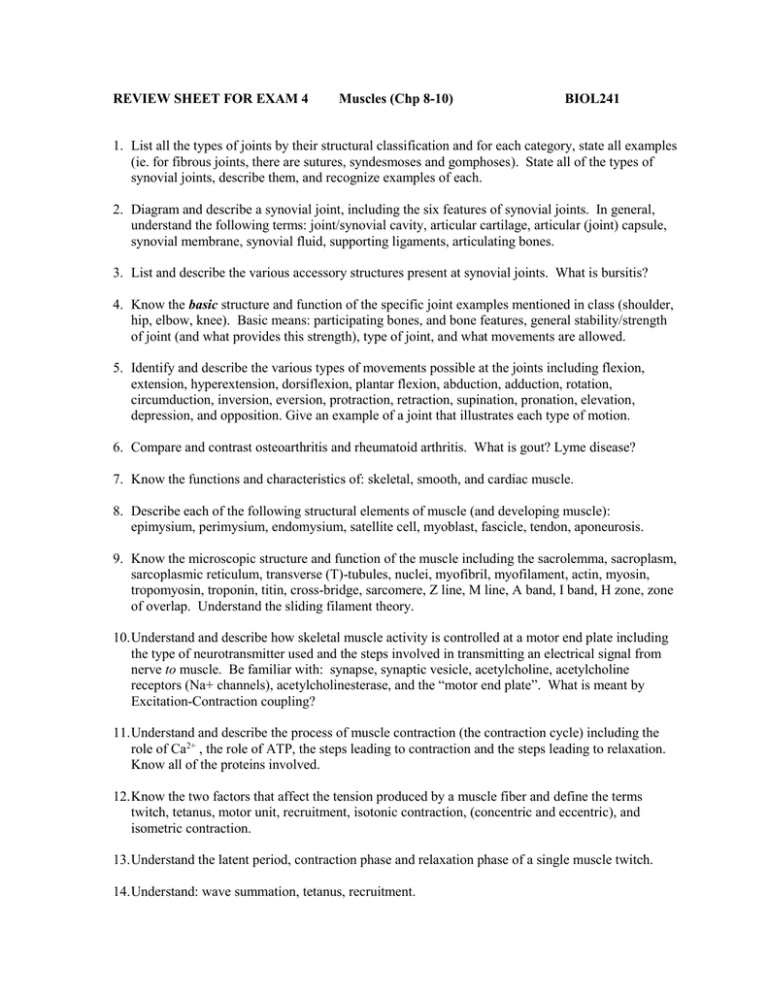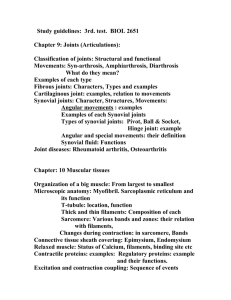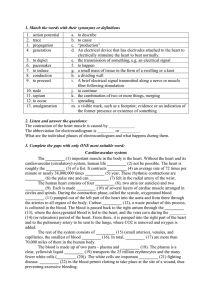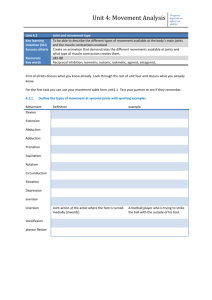REVIEW SHEET FOR EXAM 4 Muscles (Chp 8-10) BIOL241
advertisement

REVIEW SHEET FOR EXAM 4 Muscles (Chp 8-10) BIOL241 1. List all the types of joints by their structural classification and for each category, state all examples (ie. for fibrous joints, there are sutures, syndesmoses and gomphoses). State all of the types of synovial joints, describe them, and recognize examples of each. 2. Diagram and describe a synovial joint, including the six features of synovial joints. In general, understand the following terms: joint/synovial cavity, articular cartilage, articular (joint) capsule, synovial membrane, synovial fluid, supporting ligaments, articulating bones. 3. List and describe the various accessory structures present at synovial joints. What is bursitis? 4. Know the basic structure and function of the specific joint examples mentioned in class (shoulder, hip, elbow, knee). Basic means: participating bones, and bone features, general stability/strength of joint (and what provides this strength), type of joint, and what movements are allowed. 5. Identify and describe the various types of movements possible at the joints including flexion, extension, hyperextension, dorsiflexion, plantar flexion, abduction, adduction, rotation, circumduction, inversion, eversion, protraction, retraction, supination, pronation, elevation, depression, and opposition. Give an example of a joint that illustrates each type of motion. 6. Compare and contrast osteoarthritis and rheumatoid arthritis. What is gout? Lyme disease? 7. Know the functions and characteristics of: skeletal, smooth, and cardiac muscle. 8. Describe each of the following structural elements of muscle (and developing muscle): epimysium, perimysium, endomysium, satellite cell, myoblast, fascicle, tendon, aponeurosis. 9. Know the microscopic structure and function of the muscle including the sacrolemma, sacroplasm, sarcoplasmic reticulum, transverse (T)-tubules, nuclei, myofibril, myofilament, actin, myosin, tropomyosin, troponin, titin, cross-bridge, sarcomere, Z line, M line, A band, I band, H zone, zone of overlap. Understand the sliding filament theory. 10. Understand and describe how skeletal muscle activity is controlled at a motor end plate including the type of neurotransmitter used and the steps involved in transmitting an electrical signal from nerve to muscle. Be familiar with: synapse, synaptic vesicle, acetylcholine, acetylcholine receptors (Na+ channels), acetylcholinesterase, and the “motor end plate”. What is meant by Excitation-Contraction coupling? 11. Understand and describe the process of muscle contraction (the contraction cycle) including the role of Ca2+ , the role of ATP, the steps leading to contraction and the steps leading to relaxation. Know all of the proteins involved. 12. Know the two factors that affect the tension produced by a muscle fiber and define the terms twitch, tetanus, motor unit, recruitment, isotonic contraction, (concentric and eccentric), and isometric contraction. 13. Understand the latent period, contraction phase and relaxation phase of a single muscle twitch. 14. Understand: wave summation, tetanus, recruitment. 15. Describe the mechanism by which muscle fibers obtain the energy to power contractions. Be able to compare the metabolism occurring in a resting muscle to a muscle with moderate activity to a muscle at peak activity. 16. Understand the characteristics of and differences between slow oxidative, fast oxidative and fast glycolytic fibers. 17. What is Duchenne muscular dystrophy? 18. Describe the action of (and give an example of a muscle that illustrates) each of the following terms: flexor and extensor, abductor and adductor, levator and depressor, supinator and pronator, & synergist and antagonist. 19. Identify on a model or diagram each of the muscles listed on the muscles list and know the general function of each (e.g. biceps brachii muscle flexes the forearm). SEE MUSCLE LIST IN SYLLABUS




